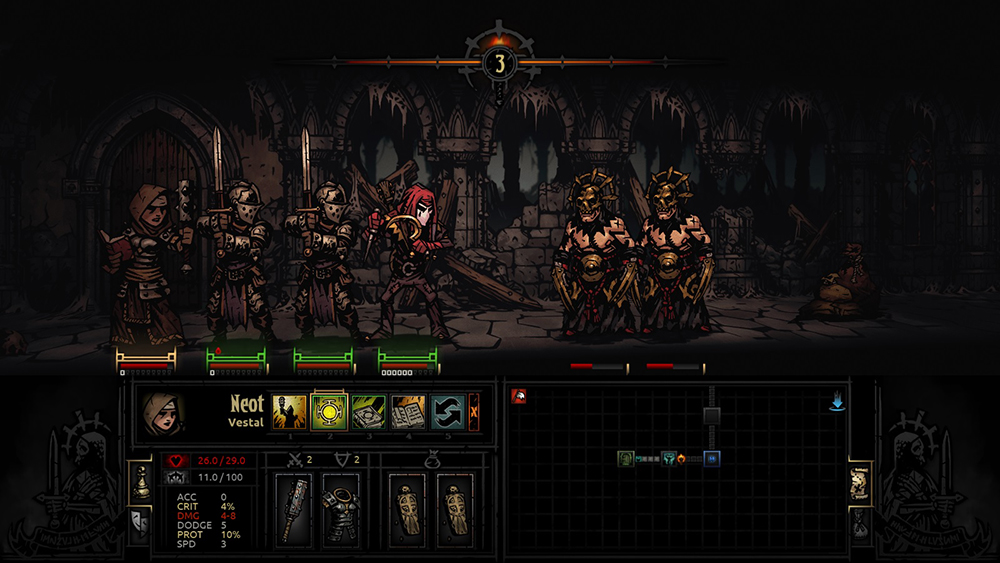Have you ever been bothered by how video game characters can shrug off terrifying psychic attacks and pour over mounds of fetid corpses for loot without a second thought? Darkest Dungeon—a turn-based, gothic-themed RPG developed by Red Hook Studies—challenges this paradigm, testing your characters’ sanity as they traverse dungeons filled with all manner of ghastly horrors.
Darkest Dungeon is a rogue-like game; if your characters perish during their struggle against monsters or even their own psyche, they will stay dead. The game offers something of a dark sense of humor toward these unforgiving conditions. With each passing day, a fresh cart of optimistic, greenhorn adventurers will arrive in town to replace those who have died on your quest to bring honor to your family name and reclaim your ancestral home.
In terms of tone and originality, Darkest Dungeon makes a welcome departure from your run-of-the-mill RPG. Character classes are fresh and original with offerings like the plague doctor, leper and grave robber that are simultaneously evocative of the game’s Gothic setting and delightfully novel in terms of how they play and interact with the world.
Aesthetically speaking, Darkest Dungeon uses lavishly illustrated sprites for characters and enemies in lieu of 3D models. Each attack for both friend and foe has its own unique sprite animation, a feature that looks really good on screen. Additionally, a narrator gives voice to everything from the game’s lore to critical hits in combat. The narration is done well enough that it plays a big part in establishing the tension you face as you explore the haunted ruins or infested warrens that dot the landscape.
While the game is quite shallow in terms of how it handles character equipment—weapons and armor are linear upgrades, with only trinkets to provide some customization—character skills offer a bit more choice in terms of how your party functions. Each class has seven combat skills but can only utilize four of them in a given encounter. The crusader class, for instance, might use Inspiring Cry to give them a clutch option for keeping their comrades sane but be left without a lot to do in ranged combat because they didn’t choose Holy Lance. Some skills have a lot of synergy with each other, so choosing the perfect set for your party can be both challenging and fun.
While Darkest Dungeon is currently only playable in a pre-release state, and it’s entirely possible that a lot will change between now and when the game launches, it does have a few issues in its current state.
Arguably the foremost among these is a matter of balance; some classes are blatantly stronger than others. While you can certainly still win with a number of different party compositions, some make the game almost trivial once they are fully equipped. Additionally, some trinkets feel wildly imbalanced even when they are equally rare. Most trinkets offer some manner of benefit at some cost, but a few of them are unilaterally beneficial and others have stats that, frankly, are overpowered.
As a result of these balance issues, the game also becomes exponentially easier as you play through it, even if you take on increasingly difficult missions. While the early game feels very punishing, a well-built party that stacks the right trinkets has virtually no risk of insanity or death even against the game’s hardest bosses.
While it certainly has its faults, Darkest Dungeon has a lot of potential if Red Hook Studies polishes it a bit before release. Even in its current state, you are bound to have a lot of fun with it before you work out the perfect party and start steamrolling through everything that moves—you can try it out for just $20 on Steam.






